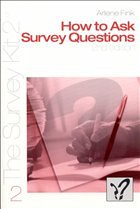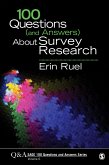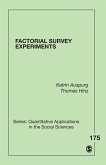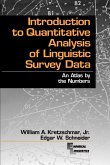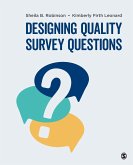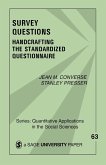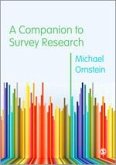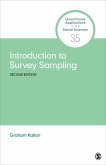Arlene G. Fink
How to Ask Survey Questions
Arlene G. Fink
How to Ask Survey Questions
- Broschiertes Buch
- Merkliste
- Auf die Merkliste
- Bewerten Bewerten
- Teilen
- Produkt teilen
- Produkterinnerung
- Produkterinnerung
Intended at helping readers prepare and use reliable and valid survey questions, this title shows readers how to: ask valid and reliable questions for the context; determine whether to use open or closed questions; and, choose the right type of measurement (categorical, nominal or ordinal) for responses to survey questions.
Andere Kunden interessierten sich auch für
![100 Questions (and Answers) About Survey Research 100 Questions (and Answers) About Survey Research]() Erin Ruel100 Questions (and Answers) About Survey Research48,99 €
Erin Ruel100 Questions (and Answers) About Survey Research48,99 €![Factorial Survey Experiments Factorial Survey Experiments]() Katrin AuspurgFactorial Survey Experiments46,99 €
Katrin AuspurgFactorial Survey Experiments46,99 €![Introduction to Quantitative Analysis of Linguistic Survey Data Introduction to Quantitative Analysis of Linguistic Survey Data]() Kretzschmar, William A., Jr.Introduction to Quantitative Analysis of Linguistic Survey Data141,99 €
Kretzschmar, William A., Jr.Introduction to Quantitative Analysis of Linguistic Survey Data141,99 €![Designing Quality Survey Questions Designing Quality Survey Questions]() Sheila B. RobinsonDesigning Quality Survey Questions85,99 €
Sheila B. RobinsonDesigning Quality Survey Questions85,99 €![Survey Questions Survey Questions]() Jean M. ConverseSurvey Questions47,99 €
Jean M. ConverseSurvey Questions47,99 €![A Companion to Survey Research A Companion to Survey Research]() Michael D. OrnsteinA Companion to Survey Research72,99 €
Michael D. OrnsteinA Companion to Survey Research72,99 €![Introduction to Survey Sampling Introduction to Survey Sampling]() Graham Kalton (Inc. Westat)Introduction to Survey Sampling51,99 €
Graham Kalton (Inc. Westat)Introduction to Survey Sampling51,99 €-
-
-
Intended at helping readers prepare and use reliable and valid survey questions, this title shows readers how to: ask valid and reliable questions for the context; determine whether to use open or closed questions; and, choose the right type of measurement (categorical, nominal or ordinal) for responses to survey questions.
Hinweis: Dieser Artikel kann nur an eine deutsche Lieferadresse ausgeliefert werden.
Hinweis: Dieser Artikel kann nur an eine deutsche Lieferadresse ausgeliefert werden.
Produktdetails
- Produktdetails
- Verlag: SAGE Publications Inc
- 2 Revised edition
- Seitenzahl: 160
- Erscheinungstermin: 22. Oktober 2002
- Englisch
- Abmessung: 229mm x 152mm x 9mm
- Gewicht: 226g
- ISBN-13: 9780761925798
- ISBN-10: 0761925791
- Artikelnr.: 22270265
- Herstellerkennzeichnung
- Libri GmbH
- Europaallee 1
- 36244 Bad Hersfeld
- gpsr@libri.de
- Verlag: SAGE Publications Inc
- 2 Revised edition
- Seitenzahl: 160
- Erscheinungstermin: 22. Oktober 2002
- Englisch
- Abmessung: 229mm x 152mm x 9mm
- Gewicht: 226g
- ISBN-13: 9780761925798
- ISBN-10: 0761925791
- Artikelnr.: 22270265
- Herstellerkennzeichnung
- Libri GmbH
- Europaallee 1
- 36244 Bad Hersfeld
- gpsr@libri.de
Arlene Fink (PhD) is Professor of Medicine and Public Health at the University of California, Los Angeles, and president of the Langley Research Institute. Her main interests include evaluation and survey research and the conduct of research literature reviews as well as the evaluation of their quality. Dr. Fink has conducted scores of evaluation studies in public health, medicine, and education. She is on the faculty of UCLA's Robert Wood Johnson Clinical Scholars Program and is a scientific and evaluation advisor to UCLA's Gambling Studies and IMPACT (Improving Access, Counseling & Treatment for Californians with Prostate Cancer) programs. She consults nationally and internationally for agencies such as L'institut de Promotion del la Prévention Secondaire en Addictologie (IPPSA) in Paris, France, and Peninsula Health in Victoria, Australia. Professor Fink has taught and lectured extensively all over the world and is the author of more than 130 peer-reviewed articles and 15 textbooks.
How to Ask Survey Questions: Learning Objectives
Ch 1. Asking Questions: A Matter of Context
Checklist for Deciding the Survey¿s Context
Guidelines for Asking Survey Questions
Guidelines for Using Conventional Language When Asking Survey Questions
Ch 2. Keep Questions Closed or Open them Up?
Open-Ended Questions
Closed or Closed-Ended Questions
Checklist for Deciding Between Open- and Closed-Ended Questions
Ch 3. Responses: Choices and Measurement
Response Choices
Categorical or Nominal Measures: How to Get Them
Categorical Responses and Who Is Eligible
Categorical Responses Are Exclusive
Categorical Responses Are Inclusive
Categorical Responses and Meaning
Questions With Ordered Responses: How to Get Ordinal Data Using Common
Rating Scales
Guidelines for Asking Closed Questions and Determining Ordered Responses or
Scales
Numerical Measures
Ch 4. Knowledge, Attitudes, and Behavior: Additional Tips for Creating
Survey Questions
Feelings and Intensity: Getting at the Attitude
Recall and Time: Getting at Behavior
Regulating Difficulty and Threat: Getting at Knowledge
Demographics: Who Are the Respondents?
Age, Income, and Education
Guidelines for Asking Questions on Vital Statistics and Demographics
Ch 5. Special Survey Questions: Factorial, Conjoint, and Online
Facturial Survey Questions: Constant or Changeable Beliefs?
Guidelines for Creating Factorial Survey Questions
Conjoint Analysis Questions: Which Do You Prefer?
Online Survey Questions
Dropdown Lists
Select One
Check All That Apply
Several Questions With the Same Response Choices
Open-Ended Questions
Ch 6. Survey Question Techniques for the Survey Team: The Focus Group
Focus Group Questions
Checklist for Conducting a Focus Group
Checklist for a Good Focus Group Question Sequence
Exercises
Answers
Suggested Readings
Glossary
About the Author
Ch 1. Asking Questions: A Matter of Context
Checklist for Deciding the Survey¿s Context
Guidelines for Asking Survey Questions
Guidelines for Using Conventional Language When Asking Survey Questions
Ch 2. Keep Questions Closed or Open them Up?
Open-Ended Questions
Closed or Closed-Ended Questions
Checklist for Deciding Between Open- and Closed-Ended Questions
Ch 3. Responses: Choices and Measurement
Response Choices
Categorical or Nominal Measures: How to Get Them
Categorical Responses and Who Is Eligible
Categorical Responses Are Exclusive
Categorical Responses Are Inclusive
Categorical Responses and Meaning
Questions With Ordered Responses: How to Get Ordinal Data Using Common
Rating Scales
Guidelines for Asking Closed Questions and Determining Ordered Responses or
Scales
Numerical Measures
Ch 4. Knowledge, Attitudes, and Behavior: Additional Tips for Creating
Survey Questions
Feelings and Intensity: Getting at the Attitude
Recall and Time: Getting at Behavior
Regulating Difficulty and Threat: Getting at Knowledge
Demographics: Who Are the Respondents?
Age, Income, and Education
Guidelines for Asking Questions on Vital Statistics and Demographics
Ch 5. Special Survey Questions: Factorial, Conjoint, and Online
Facturial Survey Questions: Constant or Changeable Beliefs?
Guidelines for Creating Factorial Survey Questions
Conjoint Analysis Questions: Which Do You Prefer?
Online Survey Questions
Dropdown Lists
Select One
Check All That Apply
Several Questions With the Same Response Choices
Open-Ended Questions
Ch 6. Survey Question Techniques for the Survey Team: The Focus Group
Focus Group Questions
Checklist for Conducting a Focus Group
Checklist for a Good Focus Group Question Sequence
Exercises
Answers
Suggested Readings
Glossary
About the Author
How to Ask Survey Questions: Learning Objectives
Ch 1. Asking Questions: A Matter of Context
Checklist for Deciding the Survey¿s Context
Guidelines for Asking Survey Questions
Guidelines for Using Conventional Language When Asking Survey Questions
Ch 2. Keep Questions Closed or Open them Up?
Open-Ended Questions
Closed or Closed-Ended Questions
Checklist for Deciding Between Open- and Closed-Ended Questions
Ch 3. Responses: Choices and Measurement
Response Choices
Categorical or Nominal Measures: How to Get Them
Categorical Responses and Who Is Eligible
Categorical Responses Are Exclusive
Categorical Responses Are Inclusive
Categorical Responses and Meaning
Questions With Ordered Responses: How to Get Ordinal Data Using Common
Rating Scales
Guidelines for Asking Closed Questions and Determining Ordered Responses or
Scales
Numerical Measures
Ch 4. Knowledge, Attitudes, and Behavior: Additional Tips for Creating
Survey Questions
Feelings and Intensity: Getting at the Attitude
Recall and Time: Getting at Behavior
Regulating Difficulty and Threat: Getting at Knowledge
Demographics: Who Are the Respondents?
Age, Income, and Education
Guidelines for Asking Questions on Vital Statistics and Demographics
Ch 5. Special Survey Questions: Factorial, Conjoint, and Online
Facturial Survey Questions: Constant or Changeable Beliefs?
Guidelines for Creating Factorial Survey Questions
Conjoint Analysis Questions: Which Do You Prefer?
Online Survey Questions
Dropdown Lists
Select One
Check All That Apply
Several Questions With the Same Response Choices
Open-Ended Questions
Ch 6. Survey Question Techniques for the Survey Team: The Focus Group
Focus Group Questions
Checklist for Conducting a Focus Group
Checklist for a Good Focus Group Question Sequence
Exercises
Answers
Suggested Readings
Glossary
About the Author
Ch 1. Asking Questions: A Matter of Context
Checklist for Deciding the Survey¿s Context
Guidelines for Asking Survey Questions
Guidelines for Using Conventional Language When Asking Survey Questions
Ch 2. Keep Questions Closed or Open them Up?
Open-Ended Questions
Closed or Closed-Ended Questions
Checklist for Deciding Between Open- and Closed-Ended Questions
Ch 3. Responses: Choices and Measurement
Response Choices
Categorical or Nominal Measures: How to Get Them
Categorical Responses and Who Is Eligible
Categorical Responses Are Exclusive
Categorical Responses Are Inclusive
Categorical Responses and Meaning
Questions With Ordered Responses: How to Get Ordinal Data Using Common
Rating Scales
Guidelines for Asking Closed Questions and Determining Ordered Responses or
Scales
Numerical Measures
Ch 4. Knowledge, Attitudes, and Behavior: Additional Tips for Creating
Survey Questions
Feelings and Intensity: Getting at the Attitude
Recall and Time: Getting at Behavior
Regulating Difficulty and Threat: Getting at Knowledge
Demographics: Who Are the Respondents?
Age, Income, and Education
Guidelines for Asking Questions on Vital Statistics and Demographics
Ch 5. Special Survey Questions: Factorial, Conjoint, and Online
Facturial Survey Questions: Constant or Changeable Beliefs?
Guidelines for Creating Factorial Survey Questions
Conjoint Analysis Questions: Which Do You Prefer?
Online Survey Questions
Dropdown Lists
Select One
Check All That Apply
Several Questions With the Same Response Choices
Open-Ended Questions
Ch 6. Survey Question Techniques for the Survey Team: The Focus Group
Focus Group Questions
Checklist for Conducting a Focus Group
Checklist for a Good Focus Group Question Sequence
Exercises
Answers
Suggested Readings
Glossary
About the Author

